Towards 5G
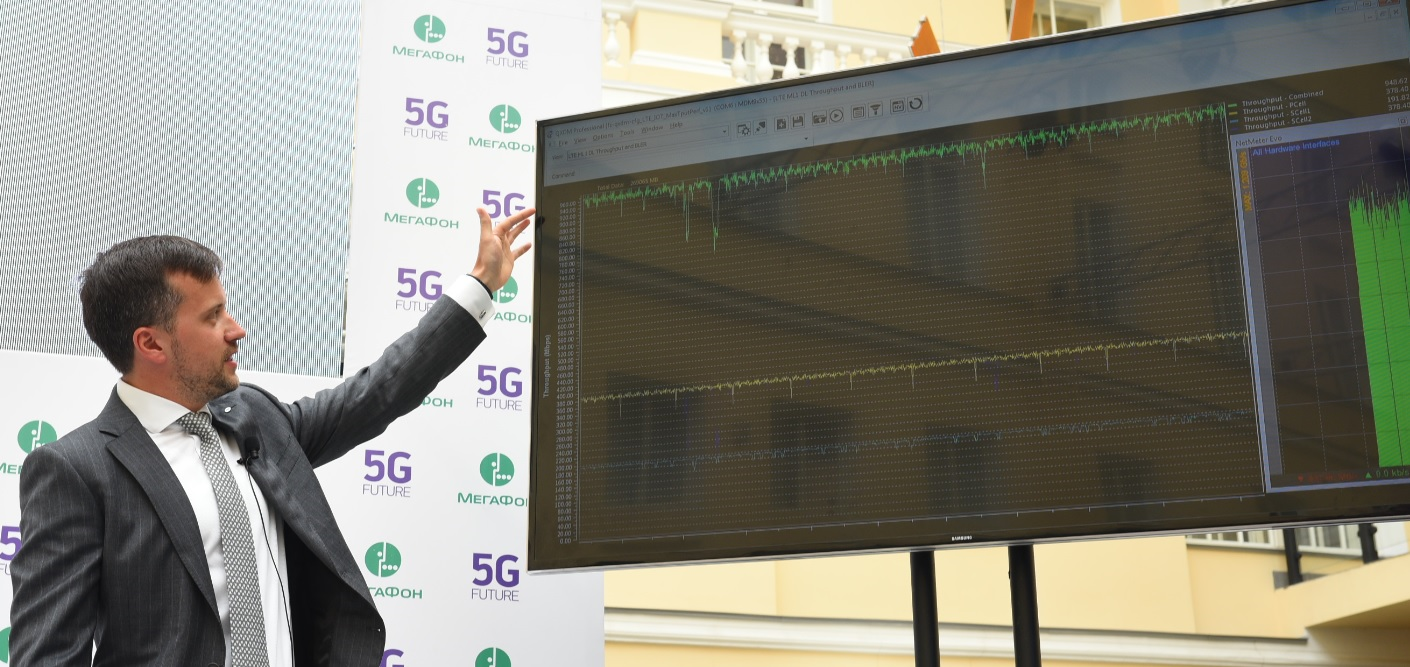
The threshold of wireless connection of 1 gigabit per second is overcome on the equipment of the commercial network, and by no other than the domestic operator of the “big three”. This is a long-awaited event for the industry, since those times when ITU published data transfer speed requirements for 4G. As time went on, on slogans of operators, attractive slogans appeared mentioning fourth-generation networks, experts claimed at international forums that LTE = 4G and that WiMAX was “not the same”, while Gigabit didn’t see any ordinary subscriber in its smartphone. And this time such a grand event could not be missed, was it really possible to disperse not only the terminal, but also the subscriber equipment to gigabit speeds, or is this another advertising duck? With this question we have to figure out below.
Generation of wireless access networks

New generations of wireless data transfer technologies are making an evolutionary leap once every 10 years. This trend has been observed since the beginning of the emergence of analog telecommunication networks in the face of NMT (Nordic Mobile Telephone) in the 1980s, when the first-generation 1G networks that appeared used analog radio signal modulation and were intended solely for transmitting voice traffic. Below is a brief description of 1G subscriber terminals:
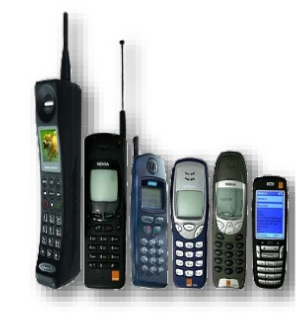
1G technology
- Uses analog signals
- 2.4 Kbps
- 150 MHz frequency and above
disadvantages
')
- Subscriber terminals weak battery
- Low voice quality
- Big sizes
- No data protection
- Frequent breaks in connections
In the early 90s, there was a leap in development, and analog wireless systems were replaced by digital ones in the form of the GSM standard that still exists today. Thanks to the use of digital methods of processing signals and data, it became possible to transmit digital information in the form of SMS messages and encrypted voice traffic. New revolutionary solutions have been called the networks of the second generation 2G. By the way, the term 1G appeared simultaneously with 2G, and from that moment the race began, in which managers tried to overtake the development of standards, calling new technologies and services emerging on the market (for example, GPRS) as 2.5G, 2.75G, etc.
2G technology
- Allows you to send SMS / MMS messages
- 64 Kbps speed
- Best voice quality compared to 1G
disadvantages
- Weak digital signal
- Poor performance, unable to process complex data (eg video)
2.5G technology
- The ability to transfer packet data using the GPRS add-on for GSM
- Receiving and sending email
- Ability to work in a web browser
- The speed of 64-144 kbps
At the beginning of the two thousandths, the International Telecommunication Union (ITU) gave the green light to the new IMT-2000 standard, which described third-generation technologies - 3G. The main requirement of the standard was to provide access to Internet services at a data transfer rate of 2 Mbit for a fixed subscriber. Due to the large amount of advertising of various telecom operators, it may not be so easy to figure out what is real 3G. Indeed, at the beginning of the 00s, a large number of IMT standard families appeared, among which the most widespread were: UMTS with broadband multiple access and W-CDMA code division; and CDMA2000 with IMT-MC. Most often, UMTS with the HSPA add-on is adopted as the standard for 3G networks, which enables high-speed transmission of packet traffic.
3G technology
- 144 Kbps speed - 2 Mbps
- Free work on the Internet: sending mail, viewing video traffic, surfing sites, etc.
- High security of personal data when working on the network
In the recent 2010 year, ITU published the requirements for fourth-generation networks. 4G was supposed to provide IP packet data rate for a mobile subscriber at 100 Mbit / s, and for a stationary one at 1 Gbit per second. It would seem that such stringent requirements of the standard are unattainable in the near future, but telecom operators and developers of telecommunications equipment are doing everything possible to be "in trend" and overtake competitors. Unfortunately, where such a race begins, users are the first to suffer. ITU imposes such stringent requirements on next-generation networks that the implementation of commercial networks that meet these requirements is often not marketable.
4G technology
- Speed 100 Mbps - 1 Gbps
- High processing speed
- Low traffic cost
- Large battery charge
- Expensive Global Networking Equipment
- The smartphone is a full user of the Internet, working in a single network with other computers
For several years now, the 4G network in the face of LTE / LTE-Advanced is “heard” by subscribers and telecom operators, but an ordinary user will never see speeds of 1 Gigabit, because for this to happen he must sit right under the base station and be the only subscriber in the sector its maintenance. In the meantime, the work on the standard of fifth-generation 5G networks is in full swing. So far, only the developed roadmap is in open access, but even from it one can gather a lot of information to understand the essence of things.
All work on the new generation of networks is carried out in the framework of IMT-2020 - a document that is a continuation of IMT-2000 and IMT-Advanced. Thus, work on the introduction of commercial 5G-networks is planned for 2020, and we have already overcome the equator. Also, the maximum information transfer rate was announced, and in the fifth generation networks it is 20 Gbit / s for a fixed subscriber. The basis for building networks with such bandwidth will form the sensational IoT (Internet of Things) with the ability to connect a million IoT devices over an area of one square kilometer. A demonstration of the capabilities of the first 5G networks is already scheduled for February 2018 at the Olympic Games in Korea.
The threshold of 1 Gigabit per second is overcome
In the Russian telecom, the development of the fifth generation networks does not stand still, and the threshold of mobile data transmission at a speed of 1 Gbit / s for a commercial network was overcome in June 2016. This is just a small step for the operator on the way to 20-gigabit speeds, but this is not the case when such speeds were demonstrated only in laboratory conditions. At the St. Petersburg International Economic Forum MegaFon, using the example of terminal equipment, Huawei demonstrated a peak data download speed of 1.24 Gbit / s. Here's how it looked at the presentation, on the left on the table you can see the Huawei terminal device, and on the right - Qualcomm LTE modem:

To demonstrate the experiment, a retrofit base station and Huawei terminal equipment were used; in the photo above, they were removed for decorative panels of white and green. The equipment used for sale on the territory of the Russian Federation has not yet appeared, so it is not possible to indicate the exact model. It is only known that this is a modification of the BS Huawei DBS3900, on board of which were more powerful processor boards that allow you to handle gigabit traffic volumes. The base station was equipped with remote active AAU3961 antenna units using standard cross-polarization +45 0 , -45 0 . It also required setting up protocols that allows you to organize a gigabit connection. Today, the Chinese company Huawei is the largest investor in the network of the fifth generation and makes a significant contribution to the study of technologies that allow to achieve ambitious speeds.
It was not possible to look inside the boxes, but in general a visual representation of the base station used can be obtained from the figure below, respectively, its RRU (left) and BBU (right) modules:
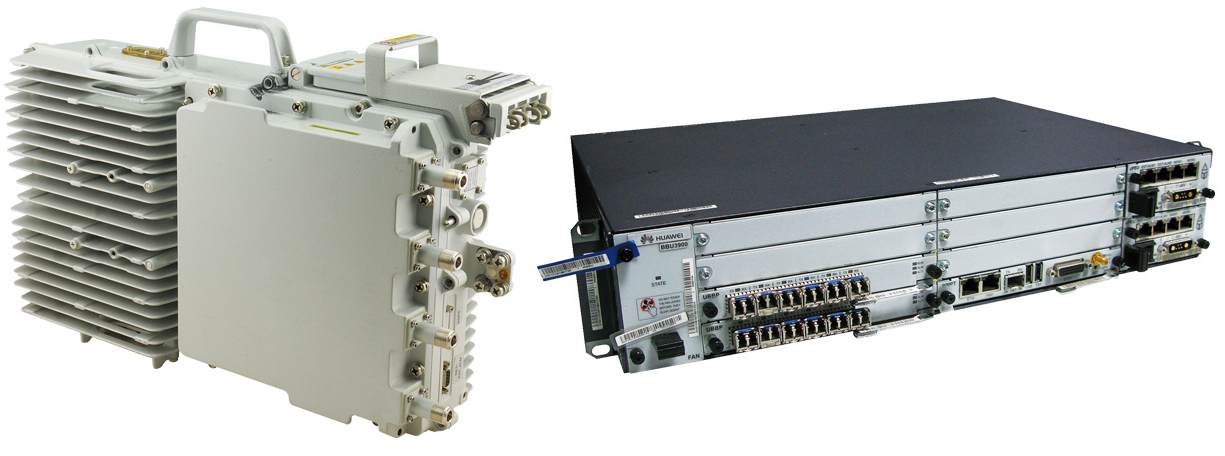
Assembly should look like this:
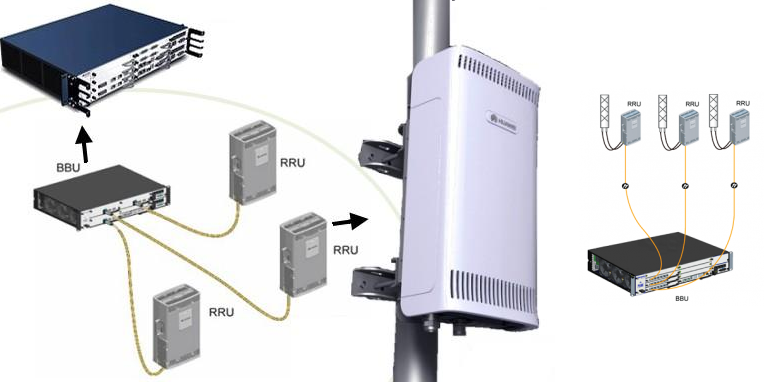
To test the bandwidth of the base station, we had to use a PC with a server network card that supports speeds up to 10 Gbit / s. The connection was made by means of an optical cable.
A modified Qualcomm Snapdragon X16 LTE modem that supports gigabit wireless connection speeds served as a subscriber unit:

The processor of this modem is capable of providing digital signal processing with a 256-QAM modulation, giving a 30% increase in data transfer speed compared to 64-QAM. And of course, when it comes to such speeds, today we cannot do without MIMO and Carrier Aggregation. In this modem, MIMO 4x4 is implemented on two carriers, in addition, the modem can aggregate four frequency channels 20 MHz wide. By the way, today in Russia there is not a single operator who could aggregate 4 carrier frequencies of 20 MHz each. Closest to this figure is MegaFon, at the disposal of which there are three carriers. The listed modem features were related to downlink traffic. For Uplink, things are no less colorful: aggregation of up to two carriers at 20 MHz, modulation of 64-QAM and support for two streams of up to 75 Mbit / s. Thus, the modem supports wireless data transfer at 1 Gbps to Downlink and 150 Mbps to Uplink.
In order to ensure the best performance of MIMO technology and provide 4x4 mode, the elegant “Qualcomm” modem had to be upgraded with four remote omni-antennas, of course, this solution is not provided in the “basic configuration” of the device.

But the Qualcomm subscriber terminal did not go to the record, although it showed speeds close to gigabits, but the Huawei terminal device:
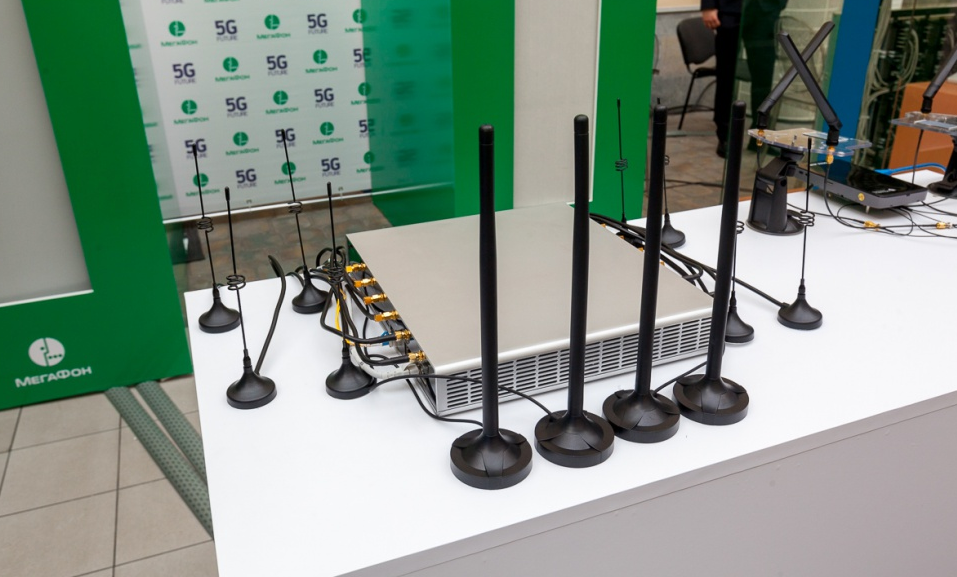
The terminal device was specifically configured for a specific task and used a total of 12 antennas: three for each band. Those that are bigger - obviously work in the 1800 MHz range. During testing, the terminal from Huawei demonstrated a maximum speed of 1.245 Gbps and an average of 1.137 Gbps:
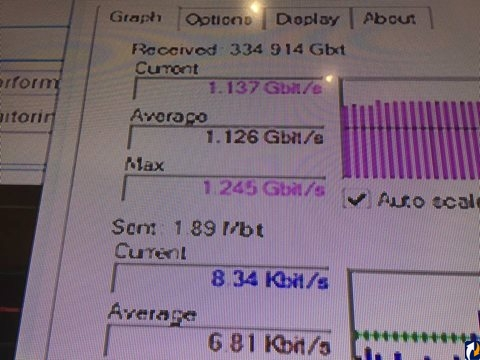
To demonstrate the stated speeds that exceed the 1 Gbit / s threshold, we used the aggregation of three carriers: 20 MHz from the 1800 MHz range (Band 3), and 20 + 20 MHz in the 2600 MHz range (Band 7). The modulation used is the maximum possible for this equipment - 256-QAM and MIMO 4x4 technology. By the way, MegaFon has repeatedly used its frequency advantages, so in early 2015, the company demonstrated a speed of 450 Mbit / s in LTE networks, also using the aggregation of three frequency channels.

Thus, the operator's integrators made a competent adjustment and debugging of the existing and commercially available top solutions for wireless technologies. The tandem operator with the largest manufacturers Qualcomm and Huawei allowed to realize this jump. And this time, the history of the development of generations of wireless access makes a new round, and the existing technical breakthrough is positioned as 4.5G. Once again, marketers take control of the standard in their own hands, following the call of the global trend. The official name of the technical solution is LTE-Advanced Pro.
Answers to integrator questions
Testing was actually carried out in ideal conditions. One subscriber was in the sector in good radio conditions, interference from neighboring cells was excluded. To say what the data transfer speed will be in real conditions is difficult, too many different factors will influence it.
The distance between the test terminal and the antenna did not exceed 5 m.
An important condition for achieving data rates of the order of 1 Gbit / s is the use of 256-QAM modulation, which gives an approximate 30% increase in data transfer speed compared to 64-QAM modulation. Peak speeds of the order of 1 Gb / s will be available to subscribers only in selected hot spots.
Technically it is possible, the issue of agreements on tariffs and content filling.
Possible scenarios for the deployment of fifth-generation networks will be clear after completion of the pilot projects of the standard in 2018. Considering the use of additional frequency bands, it is likely that modernization will be required.
Currently it is not possible to comment on this question. First of all - the radio modules.
The Qualcomm subscriber terminal prototype had dimensions of 17.5 x 8.5 x 2 cm. Yes, the prototype had four remote antennas.
The prototype provided by Qualcomm had an external power supply. Actual power consumption values will be understood after commercially available terminals appear. It should be noted that four antennas are used only for reception. For data transmission, the terminal uses only one antenna.
If we are talking about base station antennas, then they can be located in the same package of a standard antenna. For example, AAU3961 has a size of 1550 x 370 x 230 mm.
If we are talking about the antennas of the user terminal, then everything will depend on the used engineering solution of the terminal manufacturer. In the Qualcomm prototype, remote antennas were located approximately 20 cm apart.
The maximum is 10,800 subscribers for one BS board, two such cards were involved in the test layout. Actual data transfer rates at full load of equipment depend on a large number of factors: the number of active subscribers and their distribution in a cell, jamming conditions, etc.
There was a demonstration of the evolution of LTE-A. Normal CP was used. Accordingly, in each subframe there were 7 OFDM symbols.
There will be no backward compatibility of the 5G standard with previous generations. Accordingly, the subscriber with the old terminal will not be able to receive any services in the networks of the fifth generation.
Conclusion
Obviously, to ensure real data transmission speeds over a 1 Gbit / s radio channel, each subscriber will need some more time, because the implementation of fifth-generation network technologies requires replacing and upgrading not only base stations, but also mobile devices of subscribers. For them, as before, the main stumbling block is the power consumption and subtleties of the MIMO technology implementation (after all, the dimensions of mobile devices are limited), moreover, the subscriber unit processors have limited computing power, because the performance of 256-QAM modulation requires serious performance.
However, the world's leading manufacturers and developers of telecommunications equipment are working to develop devices that bring us closer to 5G networks, for example, Qualcomm has already released the Snapdragon 820 chipset for mass production, which allows downloading data to a smartphone at speeds up to 600 Mbps.
The specificity of data transmission over the radio channel has a huge amount of subtleties and nuances, and even if after a couple of years the peak data transmission speeds of the order of 1 Gbit / s are not available to ordinary mobile subscribers, then an increase in the speed of the wireless Internet by 2-3 times is exactly guaranteed. Moreover, the speed threshold is overcome, and the Internet of things has become even closer. Soon, the work of all engineering systems and gadgets from a single wireless computer network of the whole building will cease to be fiction. From managing the “smart home” to managing the “smart city” will be just a stone’s throw away. Just imagine: a city in which there are no traffic jams; a city in which information about the health of each resident is instantly transmitted to medical centers, emergency situations will be localized and prevented even before they have time to gain turnover. Perhaps this is exactly what the sixth and seventh generation wireless networks will look like?
Source: https://habr.com/ru/post/308850/
All Articles